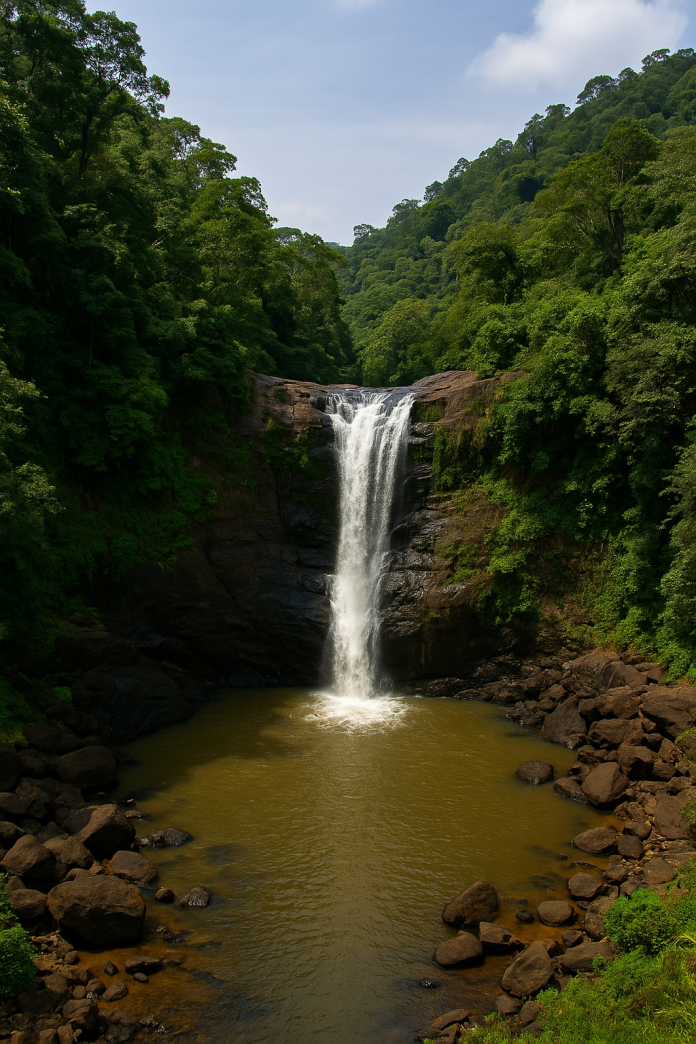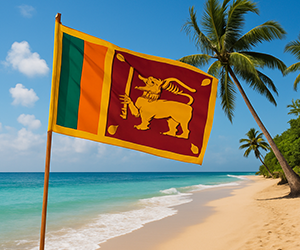Introduction
Tucked away in the lush landscapes of Sri Lanka’s Ratnapura District, Bopath Ella Waterfall is a captivating natural wonder that has captured the hearts of travelers and locals alike. With its unique shape resembling the leaf of the sacred Bo tree (Ficus religiosa), from which it derives its name, Bopath Ella stands not just as a stunning waterfall but also as a cultural, ecological, and spiritual icon.
This 30-meter waterfall is not only one of the most accessible in Sri Lanka but also steeped in legends, myths, and environmental significance. In this comprehensive guide, we delve into everything about Bopath Ella—from its geographical allure and historical backdrop to travel tips, local culture, and sustainability efforts.
The Name and Natural Shape of Bopath Ella
“Bopath” means Bo leaf, the heart-shaped leaf of the sacred fig tree revered in Buddhism. “Ella” translates to waterfall in Sinhala. True to its name, the cascading water forms a distinct Bo leaf shape as it plunges down the rocks, making it one of the most uniquely shaped waterfalls in the world.
This characteristic shape makes Bopath Ella a favorite among photographers, honeymooners, and nature lovers, who are drawn to its serene beauty and symmetrical flow.
Location and Accessibility
Where is Bopath Ella?
Bopath Ella is located in Kuruwita, approximately 3 kilometers from Ratnapura—Sri Lanka’s famed “City of Gems”. The exact coordinates place it within the Sabaragamuwa Province, nestled in a forested area teeming with biodiversity.
How to Get There
- From Colombo: 90 km (~2.5–3 hours by car)
- Public Transport: Buses and trains to Ratnapura, then tuk-tuks or local buses to Kuruwita
- Best Route: Colombo – Avissawella – Kuruwita – Bopath Ella
The waterfall is well-marked with signs, and the final 1 km requires a gentle walk through village paths and small shops—a pleasant and immersive approach.
Historical and Cultural Significance
Folklore and Legends
Bopath Ella isn’t just a feast for the eyes; it’s also wrapped in local legends and ghost stories. One tale tells of a young village girl who took her life by leaping into the waterfall after a heartbreak, and her spirit is said to still linger near the falls, weeping at dusk. This story contributes to the mystique and cultural aura of the waterfall.
Connection to Buddhism
The Bo leaf shape of the falls symbolically ties it to Buddhist reverence. The Bo tree is considered sacred because it was under such a tree that Lord Buddha attained enlightenment. Many believe visiting Bopath Ella can bring spiritual calm and blessings.
Physical and Environmental Features
Height and Flow
- Height: Approximately 30 meters (98 feet)
- Water Source: Fed by the Kuru Ganga River
- Flow Characteristics: Consistent year-round, but most powerful during the monsoon seasons (May–September)
The water cascades through a gorge before dropping in the iconic leaf-shaped veil into a natural pool that is popular for bathing and recreation.
Surrounding Flora and Fauna
The waterfall is surrounded by tropical rainforest, rich in rare plants, birds, butterflies, and reptiles. Keep an eye out for Kingfishers, Langurs, and native orchids.
Tourist Experience at Bopath Ella
What to Expect
Upon arrival, visitors are greeted by local vendors, snack shops, and craft stalls. The path to the waterfall winds through a small commercial zone before revealing the majestic falls.
Activities and Things to Do
- Photography and Nature Walks
- Bathing in the natural pool (caution advised during rainy season)
- Picnicking with friends and family
- Birdwatching and wildlife spotting
- Local cuisine sampling in nearby eateries
Best Time to Visit
- Morning hours for serenity and soft lighting
- Post-monsoon season (September–October) for the best water flow
- Weekdays to avoid local crowds
Culinary Delights and Local Food
Near the base of Bopath Ella, you’ll find small shops offering authentic Sri Lankan snacks and drinks, including:
- Kottu Roti
- Wade (Lentil fritters)
- King Coconut water
- Hoppers and Sambol
- Fresh fish curry with rice
Local food adds another layer of authenticity to the travel experience.
Safety and Sustainability
Visitor Safety Tips
- Do not swim during the rainy season due to strong currents
- Watch out for slippery rocks and leeches
- Respect signs and local guides
- Carry eco-friendly water bottles and dispose of waste responsibly
Environmental Conservation
Over the years, unregulated tourism has posed ecological threats to Bopath Ella, such as littering and water pollution. However, conservation initiatives by local authorities and NGOs have started to promote eco-tourism, education, and sustainable practices in the area.
Accommodations and Stays Nearby
Budget to Mid-Range Options
- Kuruwita Guest Houses – Affordable and family-run
- Ratnapura Boutique Stays – For more comfortable lodging
Camping and Nature Stays
Eco-lodges and camping spots are emerging in the surrounding forested areas for adventurous travelers.
Nearby Attractions to Explore
While in Ratnapura, you can explore several other gems:
- Gem Museums and Gem Mines
- Adam’s Peak (Sri Pada) – Sacred pilgrimage mountain
- Batadombalena Cave – Archaeological site of prehistoric humans
- Sinharaja Forest Reserve – UNESCO Biosphere Reserve
These nearby spots make Bopath Ella a great starting point for eco-travel itineraries in southern Sri Lanka.
Travel Tips and Practical Information
- Language: Sinhala is widely spoken, with basic English at tourist spots
- Entry Fee: Minimal or none, but parking fees may apply
- Guides: Available on-site, not mandatory
- Clothing: Light clothes, swimwear, and water shoes
- Essentials: Sunscreen, insect repellent, reusable water bottle
Bopath Ella in Art and Media
Bopath Ella has often been featured in Sri Lankan films, poetry, and photography. Its symbolic shape and powerful flow make it a favorite backdrop for wedding shoots and nature documentaries. It has also been showcased in travel blogs, vlogs, and Instagram reels, helping promote Sri Lanka tourism globally.
The Future of Bopath Ella
The challenge for Bopath Ella’s future lies in balancing tourism with conservation. Efforts are being made to introduce visitor caps, eco-education for locals and tourists, and infrastructure improvements that don’t harm the natural environment.
As Sri Lanka pivots towards responsible tourism, Bopath Ella stands as a benchmark destination for nature lovers and cultural explorers alike.
Conclusion
Bopath Ella Waterfall is more than just a pretty cascade—it’s a blend of natural beauty, folklore, spiritual significance, and ecological value. Whether you’re an adventurer, a spiritual seeker, a honeymooning couple, or a travel writer, Bopath Ella offers a slice of Sri Lankan paradise you won’t forget.
In a world that’s moving too fast, places like Bopath Ella remind us to slow down, listen to nature, and find beauty in the heart-shaped wonders that flow quietly but powerfully through the landscapes of Sri Lanka.




